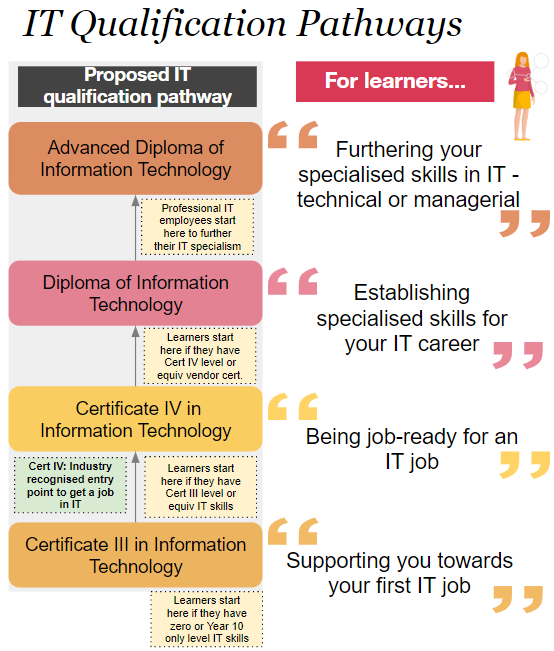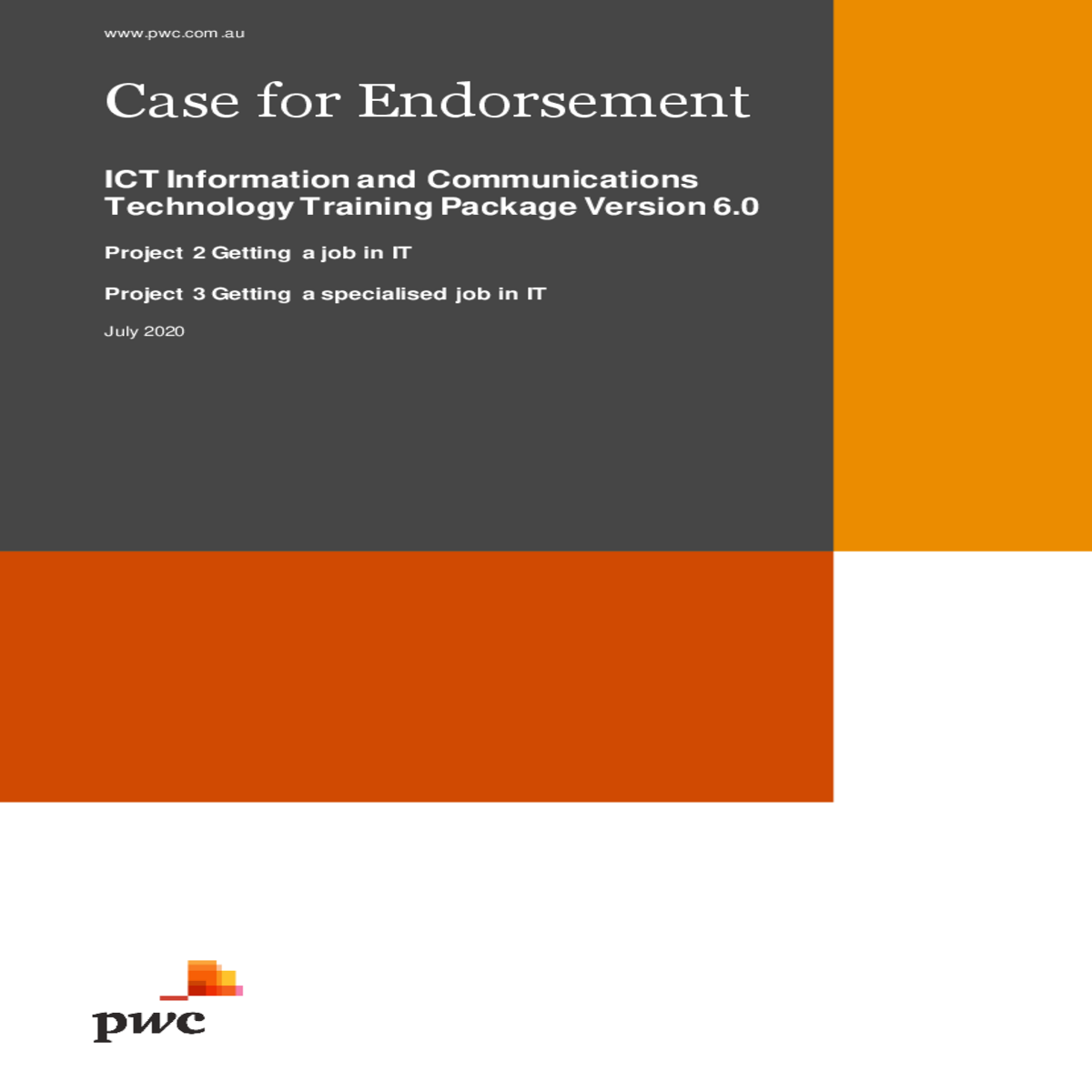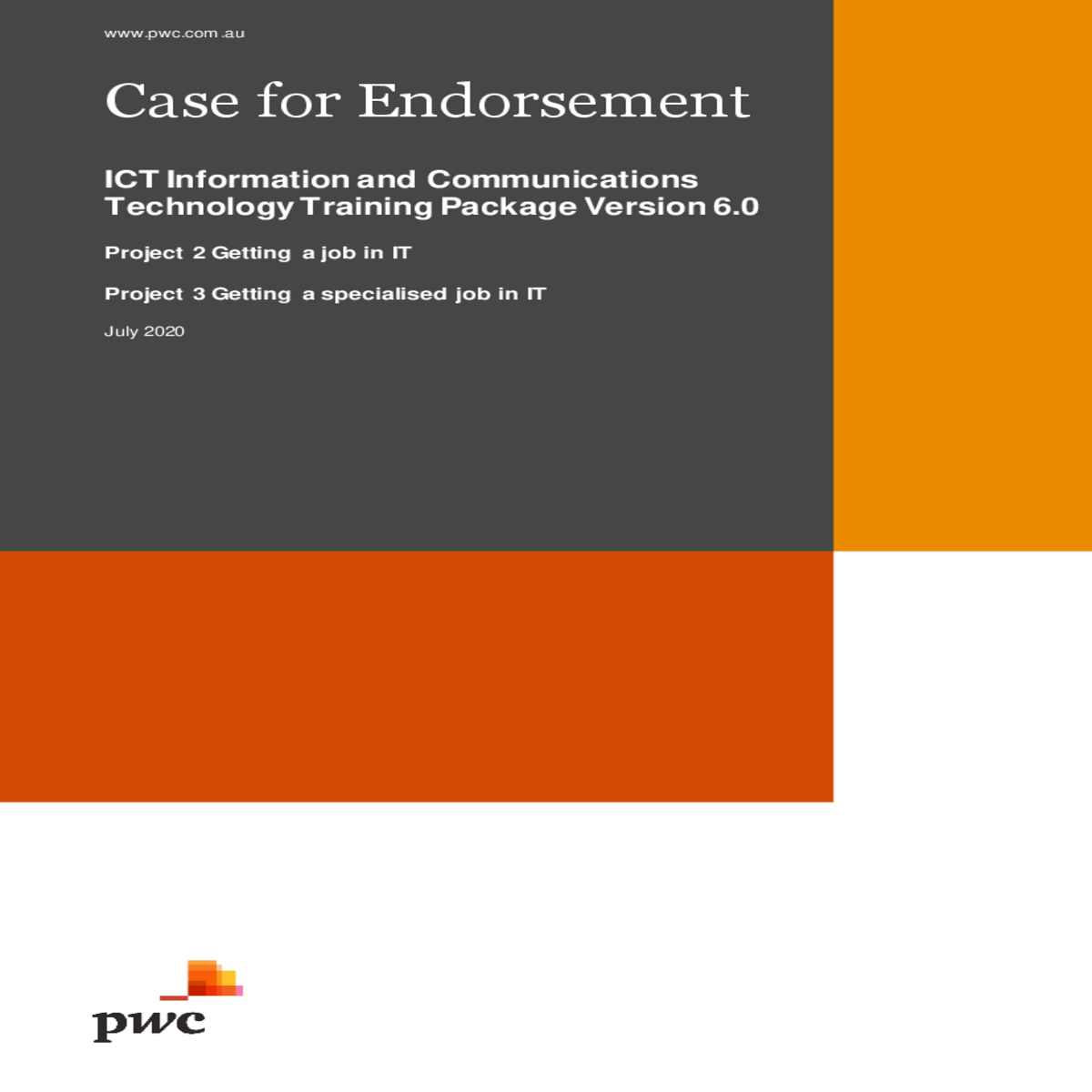Configure and test advanced server-based securityictnwk plan
|
|---|
Executive summary
It builds on the consultations undertaken by PwC’s Skills for Australia in the Cases for Change for these projects, which were submitted to the Australian Industry and Skills Committee (AISC) in June 2018 (Project 2) and December 2018 (Project 3). These projects were later combined by the ICT Industry Reference Committee (IRC) to ensure streamlining of unit content, Australian Qualification Framework (AQF) alignment, and minimisation of duplication.
The Case for Endorsement articulates the issues associated with the qualifications within the scope of the review, including learner outcomes not being to industry standard, structural industry changes not represented, and there being overlap of qualifications and duplication of units.
|
|---|
Case for Endorsement (ICT V6.0)
PwC’s Skills for Australia i
ii
Contents
Names of allocated Industry Reference Committees (IRCs)
Information and Communications Industry Reference Committee (ICT IRC)Name of Skills Service Organisation (SSO)
PwC’s Skills for Australia
| Key to mapping tables below |
|---|
Case for Endorsement (ICT V6.0)
PwC’s Skills for Australia 1
| New Code | Mapping |
|---|
|
Graduate Certificate in Information Technology and Strategic Management |
|
NE | |
|---|---|---|---|---|
| 272 updated units of competency to be submitted for endorsement | ||||
| ICTDBS403 | E | |||
| ICTDBS404 |
|
|
E | |
| ICTDBS409 | E | |||
| ICTDBS501 |
|
|
E | |
| ICTDBS502 | E | |||
| ICTDBS504 |
|
|
E | |
| ICTDBS601 | E | |||
| ICTDBS602 |
|
|
E | |
| ICTDBS603 | E | |||
| ICTDMT401 |
|
|
E | |
| ICTDMT402 | E | |||
| ICTDMT403 |
|
|
E | |
| ICTGAM401 | E | |||
| ICTGAM402 |
|
|
E | |
| ICTGAM403 | E | |||
| ICTGAM404 |
|
|
E | |
| ICTGAM405 | E | |||
| ICTGAM406 |
|
|
E | |
| ICTGAM407 | E | |||
| ICTGAM408 |
|
|
E | |
| ICTGAM409 | E | |||
| ICTGAM410 |
|
|
E | |
| ICTGAM412 | E | |||
| ICTGAM413 |
|
|
E | |
| ICTGAM414 | E | |||
| ICTGAM416 |
|
|
E | |
| ICTGAM501 | E | |||
| ICTGAM503 |
|
|
E | |
| ICTGAM504 | E | |||
| ICTGAM507 |
|
|
E | |
| ICTGAM508 | ||||
| ICTGAM509 | E | |||
| ICTGAM510 |
|
|
E | |
| ICTGAM511 | E | |||
| ICTGAM512 |
|
|
E | |
| ICTGAM514 | E | |||
| ICTGAM515 |
|
|
E | |
| ICTGAM516 | E | |||
| ICTGAM517 |
|
|
E | |
| ICTGAM518 | E | |||
| ICTGAM519 |
|
|
E | |
| ICTGAM520 | E | |||
| ICTGAM521 |
|
|
E | |
| New Code |
|
Mapping |
|---|
| Identify and manage the implementation of industry specific technologies | E | |||
|---|---|---|---|---|
|
|
E | ||
|
E | |||
|
E | |||
|
|
E | ||
|
E | |||
|
E | |||
|
|
E | ||
|
E | |||
|
E | |||
|
|
E | ||
| ICTNWK301 | E | |||
| ICTNWK302 |
|
|
E | |
| ICTNWK303 | E | |||
| ICTNWK304 |
|
|
E | |
| ICTNWK305 | E | |||
| ICTNWK306 |
|
|
E | |
| ICTNWK401 | E | |||
| ICTNWK403 |
|
|
E | |
| ICTTEN511 | ||||
| ICTNWK404 |
|
E | ||
| ICTNWK405 |
|
E | ||
| ICTNWK407 |
|
E | ||
| ICTNWK408 |
|
E | ||
| ICTNWK409 |
|
E | ||
| ICTNWK410 |
|
E | ||
| ICTNWK411 |
|
E | ||
| ICTNWK412 |
|
E | ||
| ICTNWK417 |
|
E | ||
| ICTNWK418 |
|
E | ||
| ICTNWK419 |
|
E | ||
| ICTNWK502 |
|
E | ||
| ICTNWK503 |
|
E | ||
| ICTNWK504 |
|
E | ||
| ICTNWK505 |
|
E | ||
| ICTTEN514 |
|
|||
| ICTNWK506 | E | |||
| ICTNWK507 |
|
|
E | |
| ICTNWK508 | E | |||
| ICTNWK509 |
|
|
E | |
| ICTNWK510 | E | |||
| ICTNWK511 |
|
|
E | |
| ICTTEN811 | ||||
| ICTNWK513 | E |
Case for Endorsement (ICT V6.0)
PwC’s Skills for Australia 4
PwC’s Skills for Australia 5
|
New Code | Mapping |
|---|
| ICTPRG503 |
|
|
E | |
|---|---|---|---|---|
| ICTPRG504 | E | |||
| ICTPRG505 |
|
|
E | |
| ICTPRG506 | E | |||
| ICTPRG507 |
|
|
E | |
| ICTPRG508 | E | |||
| ICTPRG510 |
|
|
E | |
| ICTPRG511 | E | |||
| ICTPRG515 |
|
|
E | |
| ICTPRG516 | E | |||
| ICTPRG517 |
|
|
E | |
| ICTPRG518 | E | |||
| ICTPRG520 |
|
|
E | |
| ICTPRG523 | E | |||
| ICTPRG524 |
|
|
E | |
| ICTPRG527 | E | |||
| ICTPRG528 |
|
|
E | |
| ICTPRG529 | E | |||
| ICTPRG601 |
|
|
E | |
| ICTPRG602 | E | |||
| ICTTEN516 | ||||
| ICTPRG604 |
|
|
E | |
| ICTSAD401 | E | |||
| ICTSAD504 |
|
|
Design and implement quality assurance processes for business solutions | E |
| ICTSAD505 | E | |||
| ICTSAD506 |
|
|
E | |
| ICTSAD601 | E | |||
| ICTSAD603 |
|
|
E | |
| ICTSAD606 | E | |||
| ICTSAD607 |
|
|
E | |
| ICTSAS201 | E | |||
| ICTSAS202 |
|
|
E | |
| ICTSAS204 | E | |||
| ICTSAS205 |
|
|
E | |
| ICTSAS206 | E | |||
| ICTSAS207 |
|
|
E | |
| ICTSAS208 | E | |||
| ICTSAS209 |
|
|
E | |
| ICTSAS306 | E | |||
| ICTSAS307 |
|
|
E | |
| ICTSAS406 | E | |||
| ICTSAS410 |
|
|
E | |
| ICTSAS411 | Update ICT client support procedures and assist with policy development | E | ||
| ICTSAS412 |
|
NE | ||
| ICTSAS413 |
|
E | ||
| ICTSAS414 |
|
E |
Case for Endorsement (ICT V6.0)
|
|---|
Case for Endorsement (ICT V6.0)
| New Code | Mapping |
|---|
| ICTWEB429 |
|
E | ||
|---|---|---|---|---|
| ICTWEB501 |
|
E | ||
| ICTWEB502 |
|
E | ||
| ICTWEB503 |
|
E | ||
| ICTWEB504 |
|
E | ||
| ICTWEB505 |
|
E | ||
| ICTWEB506 |
|
E | ||
| ICTWEB507 |
|
E | ||
| ICTWEB508 |
|
E | ||
| ICTWEB509 |
|
E | ||
| ICTWEB510 |
|
E | ||
| ICTWEB511 |
|
E | ||
| ICTWEB515 |
|
E | ||
| ICTWEB516 |
|
E | ||
| 53 newly created units of competency submitted for endorsement | ||||
|
NC | |||
|
|
NC | ||
| NC | ||||
|
|
NC | ||
|
|
NC | ||
| NC | ||||
|
|
NC | ||
|
|
NC | ||
| NC | ||||
|
|
NC | ||
|
Design and implement network security infrastructure for an organisation | NC | ||
|
NC | |||
|
|
NC | ||
|
NC | |||
|
NC | |||
|
|
NC | ||
|
NC | |||
|
NC | |||
|
|
NC | ||
|
NC | |||
|
NC | |||
|
|
NC | ||
|
NC | |||
|
NC | |||
|
|
NC | ||
|
NC | |||
|
NC | |||
|
|
NC | ||
|
NC | |||
|
NC | |||
PwC’s Skills for Australia 8
|
New Code |
|
Mapping |
|---|
| ICTPRG512 | D | |||
|---|---|---|---|---|
| ICTPRG513 |
|
|
D | |
| ICTPRG525 | D | |||
| ICTPRG526 |
|
|
D | |
| ICTSAS402 | D | |||
| ICTSAS403 |
|
|
D | |
| ICTSAS404 | D | |||
| ICTSAS407 |
|
|
D | |
| ICTSAS408 | D | |||
| ICTSAS409 |
|
|
D | |
| ICTSAS507 | Implement and evaluate systems for regulatory and standards compliance | D | ||
| ICTSUS802 |
|
|
D | |
| ICTSUS803 | D | |||
| ICTSUS808 |
|
|
D | |
| ICTWEB419 | D | |||
| ICTWEB512 |
|
|
D | |
| 9 skill sets to be created | ||||
| NC | ||||
|
|
NC | ||
|
|
NC | ||
| NC | ||||
|
|
NC | ||
|
|
NC | ||
| NC | ||||
|
|
NC | ||
|
|
NC | ||
| 2 skill sets to be deleted | ||||
| ICTSS00033 | D | |||
| ICTSS00045 |
|
|
D | |
There are were no requirements set by the AISC in relation to this training package development work.
Table 3 Activity order details
Case for Endorsement (ICT V6.0)
PwC’s Skills for Australia 11
B1. Description of work being undertaken and why
Rapid and fast-paced technology advancements are reshaping IT jobs and the skills needed to succeed as an IT professional.
The ICT sector is defined by the rapid evolution of technology. The sector plays a fundamental role in delivering skills that facilitate rapid and widespread technological change throughout the economy both within ICT and in every other industry. As computing power and big data capacity continue to exponentially grow, the rate of technological change is faster and more widespread than ever before. While many emerging technologies are now household names, such as artificial intelligence (AI), virtual reality (VR), augmented reality (AR) and the Internet of Things (IoT), it is not known how they will impact the Australian and global economy in years to come. However, it is anticipated that ICT job roles and skills will be necessary to harness the potential of new and emerging technologies. This includes an anticipated requirement for highly specialised skills, such as those related to data analytics and software engineering to design, develop and implement new technology. Digital literacy, creativity and communication skills will also be required to work effectively in the future economy, which is set to be more automated and digitally connected than ever before.
Stakeholders expressed that the current ICT qualifications are not providing the skills or job outcomes required by industry. Based on extensive industry consultation, analysis of current and historical data as well as broader national stakeholder engagement and feedback, the ICT IRC is
Case for Endorsement (ICT V6.0)
• Agility through streamlining: reducing 24 qualifications to 4 levelled qualifications, with clearer skills pathways from a
Certificate III and IV, through to a Diploma and Advanced Diploma• Flexibility at its core:as IT roles
continue to change and converge, flexibility in the form of specialisations, electives and skill sets so employers can ‘pick and choose’ with training provider engagement
updates to training standards to include up-to-date methodologies and skills in cyber, data analytics, IoT, cloud, blockchain and more
 |
|---|
Figure 2: Future state ICT qualification structure aims for flexibility, agility and design simplification for better learner outcomes
The new qualification structure will allow individuals to undertake a specialisation which directly relates to an ICT job role. These specialisations will provide greater clarity and skills recognition to employers looking to hire skilled workers.
|
|
|---|---|
|
products can be found in Appendix 8 of this Case for Endorsement.
Case for Endorsement (ICT V6.0)





